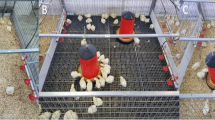Summary
Two groups of 45 Awassi ewes, were fed a control diet (group C) or a diet containing 0.30 poultry litter from laying birds (group PL). The experiment began when the rams were put with the ewes and continued through pregnancy and lactation. Mean weight changes of ewes of both groups were small and not significantly different. The numbers of ewes that lambed and the numbers of lambs weaned, as proportions of the number of ewes mated, were 0·91 and 0·73 respectively for group C, and 0·93 and 0·70 for group PL. The mean weaning weight of lambs of group C (20·6 kg) was just significantly greater than the value for group PL (18·4 kg) but the estimated mean daily milk yields, 0·716 and 0·626 kg respectively, did not differ significantly. Differences in breeding and lactation performance, between ewes given the control and those given the poultry litter diet, were small for all the data obtained. Also, there was no disease problem related to the use of poultry litter; and the food products milk and cheese, from ewes given poultry litter, were just as acceptable as those from ewes given the control diet.
Résumé
Deux groupes de 45 brebis Awassi ont reçu un régime témoin (groupe C) et un régime contenant 0,30 de résidu de litière sèche de pondeuses (groupe PL). L'expérience a débuté au moment où les béliers sont introduits parmi les femelles et s'est poursuvie pendant la gestation et l'allaitement. Les variations du poids moyen des brebis des deux groupes ont été faibles et les différences statistiquement non significatives. Le nombre d'agnelages et celui des agneaux sevrés, en tant que proportion par rapport au nombre de brebis accouplées, a été de 0,91 et 0,73, respectivement pour le groupe C, et de 0,93 et 0,70 pour le groupe PL. Le poids moyen au sevrage des agneaux du groupe C (20,6 kg) a été à peine plus élevé que le même facteur pour le groupe PL (18,4 kg), mais le rendement moyen quotidien estimé en lait: 0,716 et 0,626 kg respectivement, n'étaient pas significativement différent. Les différences dans les performances de gestation et de lactation entre les brebis nourries avec la ration témoin (C) et celles recevant le régime avec la litère de volaille séchée (PL) ont été faibles pour toutes les données obtenues. Enfin, il n'y aeu aucun problème sanitaire quant à l'emploi de la litère sèche et les produits alimentaires, lait et fromage de ces animaux étaient aussi acceptables que ceux des témoins
Resumen
Dos grupos de 45 ovejas Awassi, recibieron una dieta control (grupo C), o una dieta con 0·30 de cama de ponedoras (grupo PL). El experimento comenzó cuando los carneros fueron puestos con las hembras y continuó durante la preñez y lactación. Los cambios medios de peso de las ovejas en ambos grupos fueron pequeños y no significativamente diferentes. El número de ovejas que parieron y el número de corderos destetados, como proporción del número de ovejas apareadas, fueron 0·91 y 0·73 respectivamente para el grupo C, y 0·93 y 0·70 para el grupo PL. La media del peso de los corderos al destete pertenecientes al grupo C (20·6 kg) fue significativamente más alto que el valor obtenido para el grupo PL (18·4), pero la media estimada del producido diario de leche de los dos grupos 0·716 y 0·626 kg respectivamente, no difirieron significativamente. No hubo diferencias reproductivas, ni de lactación entre los dos grupos. Tampoco se detectaron enfermedades relacionadas con el suministro de cama de ponedoras. Los productos y subproductos lech y queso, no fueron afectados por la alimentación experimental.
Similar content being viewed by others
References
Carter, M. E. &Chengappa, M. M. (1990). Enterobacteria In:Diagnostic Procedures in Veterinary Bacteriology and Mycology. 5th ed. (Eds G. R. Carter and J. E. Cole) Academic Press.
Choueiri, E., Barr, A. M. &Khalil, K. (1966). Some reproductive and productive aspects of the Awassi sheep in Lebanon.Magon,3, 1–11 (Tel-Amara).
Epstein, H. (1977). The Awassi sheep in Israel.World Review of Animal Production,XIII, 19–26.
FAO 1985.The Awassi sheep with special reference to improved dairy type. Food and Agriculture Organisation Animal Production and Health Paper No. 57, 99–102.
Filson, D. R., Weiser, H. H., Meredith, W. E. &Winter, A. R. (1965). Absorption of chlortetracycline from alimentary tract of white leghorn hen.Poultry Science,44, 761–766.
Fontenot, J. P. &Webb, K. E. Jr. (1975). Health aspects of recycling animal wastes by feeding.Journal of Animal Science,40, 1,267–1,277.
Mason, I. L. (1967).Sheep breeds of the Mediterranean. Farnham Royal. Bucks England, Commonwealth Agricultural Bureau.
McDonald, P., Edward, R. A. &Greenhalgh, J. F. D. (1988).Animal Nutrition. 4th ed. Longman Scientific and Technical, Longman Group UK, Harlow, Essex, England, p 482.
Noland, P. R., Ford, B. F. &Ray, M. L. (1955). The use of ground chicken litter as a source of nitrogen for gestating-lactating ewes and fattening steers.Journal of Animal Science,14, 860–865.
National Research Council (1985). Nutrient requirement of sheep. National Academy of Sciences—National Research Council, Washington, D.C.
Roothaert, R. L. &Matthewman, R. W. (1992). Poultry wastes as foods for ruminants and associated aspects of animal welfare.Australasian Journal of Animal Science, (AJAS)5, 593–600.
Silanikove, N. &Tiomkin, D. (1992). Toxicity induced by poultry litter consumption effect on measurements reflecting liver function in beef cows.Animal production,54, 203–209.
Soulsby, E. J. L. (1982).Helminths, Arthropods and Protozoa of Domesticated Animals. Baillière Tindal, London.
Webb, K. E., Fontenot, J. P. &McClure, W. H. (1974). Broiler litter as a wintering feed for beef cows and heifers. U.P.I. and S.U. Research Division Report158, 123–130.
Webb, K. E., Jr. &Fontenot, J. P. (1972). Medicaina drug residues in broiler litter and tissue from cattle fed litter.Journal of Animal Science,35, 278–279.
Author information
Authors and Affiliations
Rights and permissions
About this article
Cite this article
Muwalla, M.M., Abo-Shehada, M.N., Tawfeek, F. et al. Use of dried poultry litter in the diet of pregnant and lactating Awassi ewes. Trop Anim Health Prod 27, 106–112 (1995). https://doi.org/10.1007/BF02236322
Accepted:
Issue Date:
DOI: https://doi.org/10.1007/BF02236322




